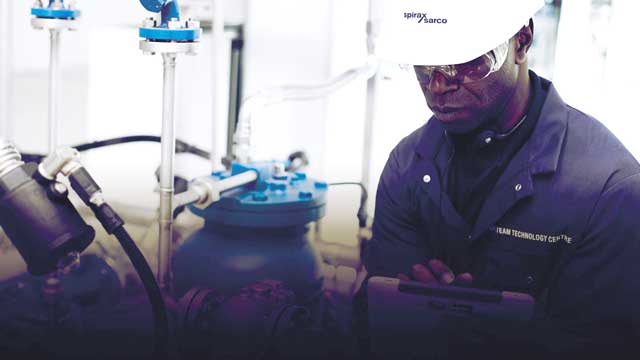
Steam is an incredible heat transfer medium, an integral, clean and essential part of modern technology in use across food, textile, chemical, medical, power, heating and transport indutries. Steam Quality Specialist Michael Hyde of Spirax Sarco argues that maintaining the quality of your steam systems is a good starting point to achieve net zero or other carbon reduction targets.
Did you know that every kilogram of steam contains around 2200 KJ of condensable energy? That’s 26 times more usable energy than a kilogram of water in a typical heating system based on flow and return temperatures with a delta of 20ÅãC!
Steam is easy to distribute and when its work is done, it is simply water – reassuring to know in our environmentally conscious world.
A sustainable and clean energy source
Steam is a reliable and more importantly, sustainable energy source. An efficient steam system targets the demands of your industrial processes, including improvement requirements for energy-saving, environmental performance, safety or regulatory compliance.
So, what does a ‘good’ steam system mean?
For your plant to operate effectively, steam should be delivered:
◆ in the correct quantity
◆ at the correct pressure and temperature
◆ clean, dry, and free from air and other non-condensable gases (NCGs)
Why is steam quality important?
Good quality steam will help you to get the best out of your applications and processes. Heating water, cooking food, drying garments, curing tyres, delivering power, or any application where steam is applied, will require steam to perform efficiently and effectively.
For steam to perform at its optimum level, the steam must be dry with a minimal amount of entrained moisture and free from NCG’s. As mentioned earlier, the steam must also be delivered at the optimum pressure and temperature.
Good quality steam ensures correct process control, short warm-up times, and maximum productivity. Using good quality steam also minimises the amount of steam used. Less steam used equates to lower running costs and reduced CO2 emissions. This can also affect the longevity and reliability of the plant. Again, in an increasingly, environmentally conscious world, reducing our footprint on the earth couldn’t be more crucial.
Steam – creating a strong foundation for your success
While steam is a very forgiving medium, you need to start with a strong platform for your success. Steam doesn’t function at its best without every level of the process being in check before it comes into play. You’ll need to have a well-designed system and the correct skills to maintain. Your system needs to be efficiently managed to ensure your productivity and sustainability targets are achieved.
On the topic of sustainability, let’s take the example of Heinz…
Yes, the beans. To help achieve their sustainability targets, Heinz reduced their carbon emissions by 200 tonnes per year. How? Simply, by improving the management of their steam system.
But their success doesn’t stop there, Heinz predict to slice more than 4% of its energy consumption in the next three years after introducing a steam trap management plan, with the help of a team of steam experts.
So, what can we take away from this? Steam is simply water – clean and environmentally friendly when managed correctly. Regular maintenance of your steam systems could help you to make big sustainability improvements and do your bit to help our planet.
If you have net zero or carbon reduction targets, then maintaining the quality of your steam and steam systems is a fantastic place to start.
e: hello@uk.spiraxsarco.com
w: www.spiraxsarco.com/global/en-GB/contact-us
t: +44 1242 521361

